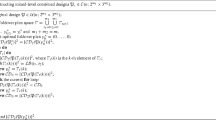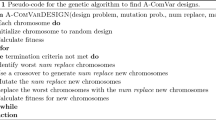Abstract
An A-optimal minimax design criterion is proposed to construct fractional factorial designs, which extends the study of the D-optimal minimax design criterion in Lin and Zhou (Canadian Journal of Statistics 41, 325–340, 2013). The resulting A-optimal and D-optimal minimax designs minimize, respectively, the maximum trace and determinant of the mean squared error matrix of the least squares estimator (LSE) of the effects in the linear model. When there is a misspecification of the effects in the model, the LSE is biased and the minimax designs have some control over the bias. Various design properties are investigated for two-level and mixed-level fractional factorial designs. In addition, the relationships among A-optimal, D-optimal, E-optimal, A-optimal minimax and D-optimal minimax designs are explored.
Similar content being viewed by others
References
Cheng, C. S., Tang, B. (2005). A general theory of minimum aberration and its applications. Annals of Statistics, 33, 944–958.
Deng, L., Tang, B. (2002). Design selection and classification for Hadamard matrices using generalized minimum aberration criteria. Technometrics, 44, 173–184.
Fedorov, V.V. (1972). Theory of Optimal Experiments. New York: Academic Press.
Lin, D. K. J., Zhou, J. (2013). D-optimal minimax fractional factorial designs. Canadian Journal of Statistics, 41, 325–340.
Mukerjee, R., Tang, B. (2012). Optimal fractions of two-level factorials under a baseline parameterization. Biometrika, 99, 71–84.
Mukerjee, R., Wu, C. F. J. (2006). A Modern Theory of Factorial Designs. New York: Springer.
Pukelsheim, F. (1993). Optimal Design of Experiments. New York: Wiley.
Sinha, B. K., Mukerjee, R. (1982). A note on the universal optimality criterion for full rank models. Journal of Statistical Planning and Inference, 7, 97–100.
Tang, B., Zhou, J. (2009). Existence and construction of two-level orthogonal arrays for estimating main effects and some specified two-factor interactions. Statistica Sinica, 19, 1193–1201.
Tang, B., Zhou, J. (2013). D-optimal two-level orthogonal arrays for estimating main effects and some specified two-factor interactions. Metrika, 76, 325–337.
Wilmut, M., Zhou, J. (2011). D-optimal minimax design criterion for two-level fractional factorial designs. Journal of Statistical Planning and Inference, 141, 576–587.
Xu, H., Phoa, F. K. H., Wong, W. K. (2009). Recent developments in nonregular fractional factorial designs. Statistics Surveys, 3, 18–46.
Acknowledgments
The authors would like to thank an associate editor and two referees for helpful comments and suggestions which have led to improvements in the presentation of this paper. This research work is supported by Discovery Grants from the Natural Science and Engineering Research Council of Canada.
Author information
Authors and Affiliations
Corresponding author
About this article
Cite this article
Yin, Y., Zhou, J. Minimax design criterion for fractional factorial designs. Ann Inst Stat Math 67, 673–685 (2015). https://doi.org/10.1007/s10463-014-0470-0
Received:
Revised:
Published:
Issue Date:
DOI: https://doi.org/10.1007/s10463-014-0470-0




